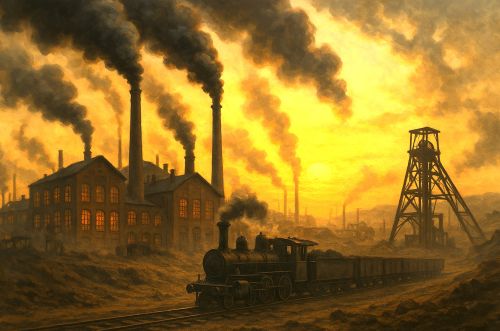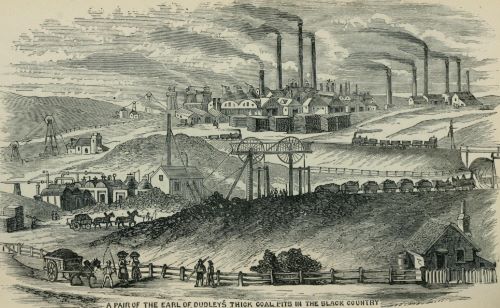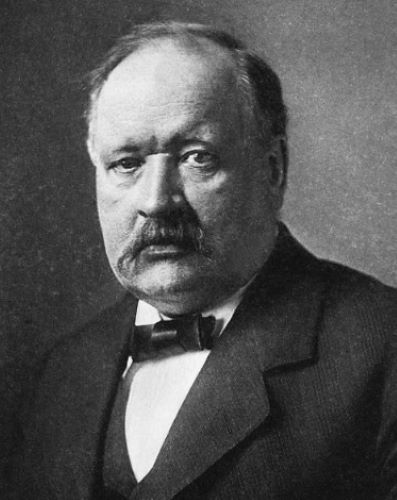

The early Industrial Revolution inaugurated more than an age of machines; it redefined the relationship between humanity and the planetary system that sustains it.

By Matthew A. McIntosh
Public Historian
Brewminate
Introduction
The onset of the early Industrial Revolution, roughly spanning the mid-eighteenth to early nineteenth centuries, marks a decisive shift in human-nature relations. During this period, the widespread adoption of fossil-fuel-driven machinery and large-scale industrial processes initiated the rapid combustion of carbon that had long been locked beneath the Earth’s surface. Prior to this era, atmospheric carbon dioxide concentrations remained relatively stable, on the order of 280 parts per million (ppm) or less, throughout the Holocene epoch.1 With the industrial age, those concentrations began a sustained upward climb that continues to the present day.2 Ice-core reconstructions confirm that pre-industrial CO2 levels were stable for millennia before this rapid rise,3 and according to the U.S. Environmental Protection Agency, they have since increased from approximately 280 ppm in the late 1700s to over 419 ppm in 2023.4 This transformation signaled not merely a change in energy systems but the beginning of a human-driven, or anthropogenic, forcing of the climate system.
In what follows I argue that the early Industrial Revolution did not simply mark the beginning of fossil-fuel use but fundamentally accelerated the transition from negligible human influence on the climate to a trajectory of growing anthropogenic greenhouse-gas emissions and climate change. The structure of the paper unfolds in four main parts. First, I establish the pre-industrial baseline of the carbon cycle and climate variability. Second, I examine how industrialization, especially the rise of coal and steam power, ushered in large-scale fossil-fuel combustion and associated emissions. Third, I link these emissions to rising greenhouse-gas concentrations and altered climate forcing. Finally, I evaluate how the early industrial phase laid the foundation for what we now recognize as modern human-induced climate change, situating that turn in its broader historical context.
Pre-Industrial Baseline: Climate and Carbon Cycle Before Industrialization

Long before the steam engines of Britain began to roar, Earth’s atmosphere operated within a finely balanced system. The Holocene epoch, beginning roughly 11,700 years ago, was marked by climatic stability and gradual, natural oscillations in temperature and greenhouse-gas levels.5 That equilibrium supported the development of agriculture, settlement, and early civilizations whose carbon footprints were negligible compared to the transformations that would follow. Natural variations in the carbon cycle (volcanic activity, oceanic absorption, and biological respiration) acted as a self-regulating network maintaining global carbon concentrations near 280 ppm.6
Ice-core records from Antarctica and Greenland provide direct evidence of this equilibrium. Gases trapped in ancient ice layers show that, for hundreds of thousands of years prior to the Industrial Revolution, atmospheric CO2 fluctuated only slightly between glacial and interglacial periods, never approaching the dramatic rise recorded after 1750.7 The carbon flux between atmosphere, biosphere, and ocean had remained in dynamic balance: the carbon emitted by decomposition or volcanic release was offset by uptake through photosynthesis and dissolution in seawater. In essence, the planet’s carbon economy was sustainable on geological timescales.
Moreover, temperature reconstructions derived from isotopic analyses align closely with these stable CO2 levels. During the mid-Holocene, mean global temperatures were relatively constant, deviating only within narrow margins of natural variability.8 This climatic steadiness was crucial to human development: it allowed for the growth of agriculture and the emergence of complex societies, all dependent on predictable seasonal patterns. Yet this same stability masked a vulnerability, Earth’s atmosphere was delicately poised, sensitive to disturbances that could alter its radiative balance.
By the eighteenth century, human activities had already begun to alter landscapes (deforestation in Europe, wetland drainage, and early metallurgy) but these processes had only localized climatic effects.9 What they did accomplish, however, was to establish the precedent of manipulating nature for economic productivity. When fossil fuels entered that equation, the impact would no longer remain regional. The pre-industrial carbon cycle thus represents a baseline, a period of near-equilibrium against which the disruptions of industrialization can be measured.
Industrial Revolution and the Shift to Fossil-Fuel Combustion

The Industrial Revolution transformed both human labor and the chemistry of the atmosphere. What began as a series of technological experiments in Britain’s textile and mining sectors evolved into an energy revolution that drew unprecedented quantities of carbon from beneath the earth. The early decades of the eighteenth century saw a rapid expansion of coal mining in northern England, Wales, and Scotland, where shallow seams made extraction economically feasible.10 The invention and refinement of the steam engine, most notably by James Watt after 1769, multiplied the utility of coal beyond metallurgy, providing continuous power for mills, transport, and manufacturing.11
Coal combustion released immense amounts of carbon dioxide directly into the atmosphere, establishing an industrial metabolism dependent on fossil carbon rather than organic or renewable sources. By the early nineteenth century, Britain had become the world’s first fossil-fuel society, producing millions of tons of coal annually to drive steam engines, iron foundries, and railways.12 This marked a decisive break with the energy regimes of earlier centuries, which relied on wood, water, and animal power, sources bound by ecological limits. In contrast, coal offered concentrated energy at a scale seemingly infinite to contemporaries, yet its by-product, CO2, accumulated invisibly in the atmosphere.
The transition from wood to coal was not merely quantitative but qualitative. Historian E. A. Wrigley describes it as the shift from an “organic economy” to a “mineral economy,” in which stored solar energy, ancient plant matter fossilized over millions of years, was suddenly liberated within decades.13 The industrial use of fossil carbon broke the temporal equilibrium of the carbon cycle: carbon once locked away through geological processes was rapidly oxidized and returned to the atmosphere, upsetting the balance that had held throughout the Holocene.
Quantitative reconstructions confirm the scale of this transformation. Estimates from the Carbon Dioxide Information Analysis Center indicate that global anthropogenic emissions of CO₂ from fossil-fuel combustion were already measurable by 1750 and had increased roughly ten-fold by 1850, continuing to rise exponentially thereafter to more than 350 times their eighteenth-century levels today.14 The rise of coal-fired steam engines, railways, and smelting furnaces thus established a new climatic trajectory, one in which industrial productivity and atmospheric alteration advanced together. Early observers could not yet discern the climatic consequences, but they had begun an experiment on a planetary scale, one whose results would unfold across centuries.
Linkage from Fossil-Fuel Emissions to Greenhouse-Gas Concentrations and Climate Forcing

The relationship between fossil-fuel combustion and atmospheric change is now established beyond dispute, but its origins lie in the industrial innovations of the eighteenth and nineteenth centuries. The carbon released by coal and later by oil and natural gas did not simply disperse; it accumulated. The atmospheric record, reconstructed from ice cores and supplemented by direct measurements since 1958, shows a clear inflection point beginning around 1750, coinciding precisely with the rise of industrial energy use.15 In the centuries before industrialization, carbon dioxide levels fluctuated within narrow bounds, but the industrial era produced a sharp and sustained upward curve. The timing of this divergence eliminates natural cycles as the dominant cause.
As fossil-fuel combustion intensified, greenhouse gases began to trap heat that would otherwise escape into space. Carbon dioxide, methane, and nitrous oxide absorb infrared radiation and re-emit it, warming the lower atmosphere and surface.16 This “greenhouse effect,” first quantified in principle by nineteenth-century scientists such as John Tyndall and Svante Arrhenius, became a measurable forcing mechanism by the twentieth century. Modern radiative-transfer models confirm that the additional CO2 from industrial sources produces a net positive energy imbalance at Earth’s surface.17 While natural processes continue to exchange carbon between atmosphere and biosphere, human emissions have tipped that equilibrium toward accumulation rather than balance.
The physical record of this change is unambiguous. Ice-core data from Antarctica reveal that CO2 concentrations remained below 300 parts per million for at least 800,000 years prior to industrialization. By 2023, the global mean exceeded 419 ppm.18 Methane and nitrous oxide show parallel trends, with steep rises since the late eighteenth century, confirming that the new emissions were not isolated phenomena but part of a systemic shift in atmospheric chemistry. These changes have altered Earth’s radiative forcing, the balance between energy entering from the sun and leaving as infrared radiation, by an estimated 2.7 watts per square meter since 1750.19
The signature of human causation appears not only in concentration levels but also in isotopic ratios. Carbon derived from fossil fuels bears a distinct isotopic fingerprint: a depletion in carbon-13 relative to carbon-12. Measurements of atmospheric CO2 isotopes demonstrate that the additional carbon entering the atmosphere since industrialization is overwhelmingly of fossil origin.20 This finding eliminates alternative explanations such as volcanic activity, which would enrich, not deplete, carbon-13. The isotopic evidence thus provides a molecular record of humanity’s combustion history.
Taken together, the data reveal a continuous feedback between industrial energy systems and the global climate. The burning of fossil carbon introduced a long-term forcing mechanism whose effects extend beyond immediate warming to the alteration of ocean chemistry, hydrological cycles, and biospheric processes. What began as local smoke from British chimneys became a planetary influence measurable across polar ice, ocean depths, and the upper atmosphere. The Industrial Revolution therefore represents not just a turning point in economic history but a threshold in Earth’s environmental evolution, a moment when the carbon cycle ceased to be governed by nature alone.
Evidence of Climate System Response and the “Acceleration” Effect

By the late nineteenth century, the effects of accumulated greenhouse gases were no longer confined to the theoretical realm. Instrumental temperature records, initiated in the 1850s, show a discernible warming trend that closely tracks the rise in atmospheric carbon dioxide.21 When averaged globally, surface temperatures increased by roughly one degree Celsius since pre-industrial times, a rate unprecedented in the context of the past several millennia.22 This change may appear modest, but in climatic terms it represents a shift large enough to alter weather systems, ocean currents, and ecological zones. The industrial age thus introduced not only new energy sources but also new physical consequences embedded in Earth’s systems.
The ocean, covering more than two-thirds of the planet’s surface, has absorbed over ninety percent of the excess heat trapped by greenhouse gases.23 This process has buffered immediate atmospheric warming but has also altered ocean circulation and stratification. Thermal expansion of seawater has contributed substantially to global sea-level rise, while the uptake of carbon dioxide has decreased oceanic pH by nearly 0.1 units since 1850.24 These chemical shifts mark the beginning of ocean acidification, reducing carbonate availability for shell-forming organisms and disrupting marine ecosystems that had remained stable for millions of years.
Cryospheric evidence reinforces this narrative of acceleration. Satellite and glacial observations reveal that Arctic sea ice extent has declined by more than forty percent since 1979, and the Greenland and Antarctic ice sheets are now losing hundreds of billions of tons of ice annually.25 The retreat of alpine glaciers across Europe and South America provides direct visual testimony of global temperature rise. These frozen archives not only record past climate conditions through trapped gases but are themselves victims of the warming they document.
Atmospheric dynamics have also shifted in response to increased radiative forcing. Warmer air holds more moisture, intensifying both droughts and floods depending on regional circulation.26 The frequency of extreme weather events (heat waves, hurricanes, and wildfires) has increased in correlation with the global temperature curve, though attribution studies carefully distinguish natural variability from anthropogenic trends. The statistical convergence of models and observations, however, leaves little doubt that the accelerating accumulation of greenhouse gases amplifies climate extremes.
Ecological systems register these changes through altered growing seasons, poleward migration of species, and disruptions in phenological cycles.27 Forests that once acted as carbon sinks are increasingly subject to drought and fire, converting them intermittently into carbon sources. Feedback loops of this kind intensify the overall rate of change: as warming undermines natural absorbers of carbon, the residual atmospheric concentration grows even faster. In this sense, the “acceleration effect” refers not only to the pace of industrial emissions but also to the cascading feedbacks they have unleashed.
Taken together, the thermal, cryospheric, and biospheric data confirm that the Industrial Revolution initiated a self-reinforcing cycle of anthropogenic climate change. The initial pulse of fossil-fuel emissions has propagated through every major Earth system, manifesting as measurable increases in temperature, altered ocean chemistry, and ecological transformation.28 The acceleration that began in the age of coal has not abated; it defines the trajectory of the modern world.
Broader Historical and Historiographical Significance

Historians increasingly recognize the Industrial Revolution as the decisive threshold in the long environmental history of humankind. Before this era, human activity had influenced landscapes but not the planetary system itself. Industrialization changed that relationship by linking economic growth to fossil-carbon consumption, embedding energy extraction at the center of modern civilization.29 This was not simply a technological innovation but an ecological reordering: the reconfiguration of nature as both raw material and waste sink. The rise of industrial capitalism therefore initiated what some scholars term the Anthropocene, an epoch in which human industry became a geophysical force.
The historiography of climate change has evolved from narrow scientific explanation toward a broader synthesis that situates industrialization within social and cultural contexts. Environmental historians such as John McNeill and J. R. McNeill emphasize how the nineteenth-century fusion of coal, capital, and empire created a feedback loop between industrial growth and atmospheric transformation.30 Recent scholarship argues that the Industrial Revolution’s energy regime was inseparable from the imperial economies that expanded it, exporting both technologies and emissions around the globe.31 Thus the acceleration of human-caused climate change cannot be understood in isolation from the global political economy that sustained it.
This perspective reframes the Industrial Revolution not as an isolated British phenomenon but as the opening act of a planetary process. As industrial methods spread to continental Europe, North America, and later Asia, each region reproduced the same dependence on fossil fuels that had originated in eighteenth-century Britain.32 The subsequent diffusion of railways, steamships, and mechanized industry ensured that carbon emissions became embedded in the very structure of global modernity. The problem of climate change, therefore, is not a deviation from industrial progress but one of its defining outcomes.
Recognizing this continuity reshapes our moral and historical understanding of responsibility. The climate crisis of the twenty-first century is not a sudden anomaly but the cumulative expression of choices made during the first century of industrialization. To grasp the origins of anthropogenic climate change is to acknowledge that modern prosperity was built upon a carbon debt now coming due. The early Industrial Revolution thus stands as both a triumph of ingenuity and a cautionary chapter in the human story, a reminder that technological power, once unmoored from ecological limits, can alter the very conditions of life on Earth.33
Conclusion
The early Industrial Revolution inaugurated more than an age of machines; it redefined the relationship between humanity and the planetary system that sustains it. The transition from organic to fossil energy altered the carbon cycle so profoundly that Earth’s climate began to respond within a single human lifetime.34 From coal-fired steam engines in eighteenth-century Britain to the global networks of industry that followed, the arc of progress became inseparable from the accumulation of atmospheric carbon. The revolution’s engines thus became the planet’s metronomes, keeping time not only for economic growth but for rising global temperatures.
The acceleration of anthropogenic climate change that began in this period continues unabated. Each successive technological advance (oil extraction, electricity generation, motor transport) has deepened the industrial pattern of energy dependency first set in motion by coal.35 The consequences are now visible in melting ice sheets, shifting rainfall patterns, and degraded ecosystems. Yet these outcomes are not merely environmental; they are historical, the legacy of decisions embedded in the logic of industrial modernity.
Understanding this continuity reframes the question of responsibility. The early industrialists did not foresee the planetary scale of their impact, but their innovations created a trajectory that later generations extended rather than reversed.36 To confront climate change today is therefore to reckon with the historical structures that made it possible, economic systems that rewarded extraction and consumption while externalizing environmental cost. The path to mitigation requires not only technological reform but also a re-examination of the industrial narrative itself.
In tracing this origin, we uncover a paradox: the same ingenuity that powered human advancement also destabilized the climate that made such advancement possible. The Industrial Revolution remains a monument to creativity and a warning of consequence. Its legacy endures in the carbon now diffused through air and ocean, a silent archive of history written not in ink but in parts per million.37
Appendix
Footnotes
- National Oceanic and Atmospheric Administration (NOAA), Climate Change: Atmospheric Carbon Dioxide, accessed October 2025.
- Ibid.
- D. Lüthi et al., “High-Resolution Carbon Dioxide Concentration Record 650,000–800,000 Years before Present,” Nature 453 (2008): 379–382.
- United States Environmental Protection Agency (EPA), “Atmospheric Concentrations of Greenhouse Gases,” accessed October 2025.
- Intergovernmental Panel on Climate Change (IPCC), Climate Change 2021: The Physical Science Basis (Cambridge: Cambridge University Press, 2021), 5–6.
- NOAA, Climate Change: Atmospheric Carbon Dioxide, accessed October 2025.
- Eric W. Wolff et al., “Climate Change and Ice Cores,” Teaching Earth Sciences 36, no. 2 (2011): 26-29.
- NASA Goddard Institute for Space Studies (GISS), Global Surface Temperature Change, accessed October 2025.
- Clive Ponting, A New Green History of the World: The Environment and the Collapse of Great Civilizations (New York: Penguin, 2007), 114–116.
- Robert C. Allen, The British Industrial Revolution in Global Perspective (Cambridge: Cambridge University Press, 2009), 34–37.
- Ben Marsden and Crosbie Smith, Engineering Empires: A Cultural History of Technology in Nineteenth-Century Britain (Basingstoke: Palgrave Macmillan, 2005), 22–25.
- Rolf Peter Sieferle, The Subterranean Forest: Energy Systems and the Industrial Revolution (Cambridge: White Horse Press, 2001), 83–87.
- E. A. Wrigley, Energy and the English Industrial Revolution (Cambridge: Cambridge University Press, 2010), 18–21.
- Dennis Gilfillian and Gregg Marland, “CDIAC-FF: Global and National CO2 Emissions from Fossil Fuel Combustion and Cement Manufacture: 1751-2017,” Earth System Science Data 13, no. 4 (2021): 1667-2021.
- NOAA, Climate Change: Atmospheric Carbon Dioxide, accessed October 2025.
- EPA, Climate Change Science: Causes of Climate Change, accessed October 2025.
- IPCC, Climate Change 2021: The Physical Science Basis (Cambridge: Cambridge University Press, 2021), 122–124.
- Eric W. Wolff et al., “High-Resolution Carbon Dioxide Concentration Record 650,000–800,000 Years before Present,” Nature 453 (2008): 379–382.
- IPCC, Climate Change 2021: The Physical Science Basis, 137.
- Pieter Tans, “An Accounting of the Observed Increase in Oceanic and Atmospheric CO₂ and an Outlook for the Future,” Oceanography 22:4 (December 2009), 26-35.
- National Aeronautics and Space Administration (NASA), Global Climate Change: Vital Signs of the Planet, accessed October 2025.
- IPCC, Climate Change 2021, 5.
- NOAA, Ocean Heat Content Data, accessed October 2025.
- NOAA, Ocean Acidification: The Other Carbon Dioxide Problem, accessed October 2025.
- NASA Jet Propulsion Laboratory, GRACE Follow-On Mission: Ice Mass Loss Data, accessed October 2025.
- IPCC, Climate Change 202, 256–258.
- EPA, Climate Change Indicators: Ecosystems and Phenology, accessed October 2025.
- NOAA, State of the Climate 2024: Global Annual Report, accessed October 2025.
- Dipesh Chakrabarty, The Climate of History in a Planetary Age (Chicago: University of Chicago Press, 2021), 41–45.
- J. R. McNeill and Peter Engelke, The Great Acceleration: An Environmental History of the Anthropocene since 1945 (Cambridge, MA: Harvard University Press, 2016), 8–10.
- Andreas Malm, Fossil Capital: The Rise of Steam Power and the Roots of Global Warming (London: Verso, 2016), 37–40.
- Paul Warde, The Invention of Sustainability: Nature and Destiny, c. 1500–1870 (Cambridge: Cambridge University Press, 2018), 233–236.
- Naomi Oreskes and Erik M. Conway, Merchants of Doubt: How a Handful of Scientists Obscured the Truth on Issues from Tobacco Smoke to Global Warming (New York: Bloomsbury Press, 2010), 265–267.
- J. R. McNeill, Something New Under the Sun: An Environmental History of the Twentieth-Century World (New York: W. W. Norton, 2000), 15–18.
- Vaclav Smil, Energy and Civilization: A History (Cambridge, MA: MIT Press, 2017), 240–244.
- Timothy Mitchell, Carbon Democracy: Political Power in the Age of Oil (London: Verso, 2011), 13–16.
- IPCC, Climate Change 2021, SPM-7.
Bibliography
- Allen, Robert C. The British Industrial Revolution in Global Perspective. Cambridge: Cambridge University Press, 2009.
- Chakrabarty, Dipesh. The Climate of History in a Planetary Age. Chicago: University of Chicago Press, 2021.
- Gilfillian, Dennis, and Gregg Marland. “CDIAC-FF: Global and National CO2 Emissions from Fossil Fuel Combustion and Cement Manufacture: 1751-2017.” Earth System Science Data 13, no. 4 (2021): 1667-1680.
- Intergovernmental Panel on Climate Change (IPCC). Climate Change 2021: The Physical Science Basis. Cambridge: Cambridge University Press, 2021.
- Marsden, Ben, and Crosbie Smith. Engineering Empires: A Cultural History of Technology in Nineteenth-Century Britain. Basingstoke: Palgrave Macmillan, 2005.
- Malm, Andreas. Fossil Capital: The Rise of Steam Power and the Roots of Global Warming. London: Verso, 2016.
- McNeill, J. R. Something New Under the Sun: An Environmental History of the Twentieth-Century World. New York: W. W. Norton, 2000.
- McNeill, J. R., and Peter Engelke. The Great Acceleration: An Environmental History of the Anthropocene since 1945. Cambridge, MA: Harvard University Press, 2016.
- Mitchell, Timothy. Carbon Democracy: Political Power in the Age of Oil. London: Verso, 2011.
- National Aeronautics and Space Administration (NASA). Global Climate Change: Vital Signs of the Planet. Accessed October 2025.
- National Aeronautics and Space Administration (NASA) Jet Propulsion Laboratory. GRACE Follow-On Mission: Ice Mass Loss Data. Accessed October 2025.
- National Oceanic and Atmospheric Administration (NOAA). Climate Change: Atmospheric Carbon Dioxide. Accessed October 2025.
- ———. Ocean Acidification: The Other Carbon Dioxide Problem. Accessed October 2025.
- ———. Ocean Heat Content Data. Accessed October 2025.
- ———. State of the Climate 2024: Global Annual Report. Accessed October 2025.
- Oreskes, Naomi, and Erik M. Conway. Merchants of Doubt: How a Handful of Scientists Obscured the Truth on Issues from Tobacco Smoke to Global Warming. New York: Bloomsbury Press, 2010.
- Ponting, Clive. A New Green History of the World: The Environment and the Collapse of Great Civilizations. New York: Penguin, 2007.
- Sieferle, Rolf Peter. The Subterranean Forest: Energy Systems and the Industrial Revolution. Cambridge: White Horse Press, 2001.
- Smil, Vaclav. Energy and Civilization: A History. Cambridge, MA: MIT Press, 2017.
- Tans, Pieter. “An Accounting of the Observed Increase in Oceanic and Atmospheric CO₂ and an Outlook for the Future.” Oceanography Vol. 22, No. 4 (December 2009), 26-35.
- United States Environmental Protection Agency (EPA). Atmospheric Concentrations of Greenhouse Gases. Accessed October 2025.
- ———. Climate Change Indicators: Ecosystems and Phenology. Accessed October 2025.
- ———. Climate Change Science: Causes of Climate Change. Accessed October 2025.
- Warde, Paul. The Invention of Sustainability: Nature and Destiny, c. 1500–1870. Cambridge: Cambridge University Press, 2018.
- Wolff, Eric W., et al. “Climate Change and Ice Cores.” Teaching Earth Sciences 36, no. 2 (2011): 26-29.
- Wrigley, E. A. Energy and the English Industrial Revolution. Cambridge: Cambridge University Press, 2010.
Lüthi, D., et al. “High-Resolution Carbon Dioxide Concentration Record 650,000–800,000 Years before Present.” Nature 453 (2008): 379–382.
Originally published by Brewminate, 11.03.2025, under the terms of a Creative Commons Attribution-NonCommercial-NoDerivatives 4.0 International license.


